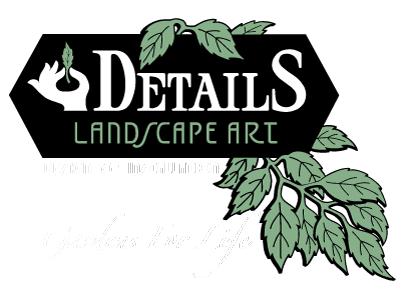Vines are an interesting type of plant, with many useful applications, but with some maintenance issues, depending on use and location. Details Landscape Art, a leading landscape contractor located in Petaluma, has designed and built beautiful gardens since 1991. One of the various types of plant material we like to use is the vine.
Vines come in all sizes and colors, both evergreen and deciduous, and climb in different ways. One of their distinguishing characteristics is their tractable, pliable branches. As opposed to the inflexible, rigid branches of most other plants and trees, vines can be trained to climb up the posts of an arbor or tree, or horizontally on a fence or wall. They climb either by tendrils, by twining, or by clinging. Others must simply be tied to their support.
In the typical small, fenced, residential garden in Northern California, a vine is a way to cover a fence in a relatively flat fashion, in contrast with a screening shrub whose width may take up significant ground space. Bear in mind, however, when it’s time to replace the fence or some fence boards, or if staining is desired, the vine must be taken down. Similarly, a vine climbing up an arbor can be gorgeous, but when it’s time to stain or paint the arbor, it vine must come down. They can be slow to get started, then become aggressive as they become established. Pruning and training are usually required. They are not maintenance free.
Following is a list of both evergreen and deciduous vines we like to use…we have excluded those which are not likely to survive a freeze, such as bougainvillea or pink jasmine:
Evergreen-
- Clytostoma callistegoides (lavender trumpet vine) – slow to start then they really take off. Beautiful trumpet shaped flowers for six weeks in spring.
- Trachelospermum jasminoides (star jasmine) – profusion of white flowers from spring through summer into fall. Very fragrant, easy to train horizontally. Very aggressive, needs occasion pruning to keep under control. Tolerates full sun, but performs better and has darker green foliage with afternoon shade.
- Hardenbergia (lilac vine) – beautiful purple flowers in late winter
- Gelsenium sempervirens (Carolina Jessamine) – shiny medium green leaves on hanging branches. Late winter to early spring bloom season. Fragrant yellow flowers are tubular in shape. Tolerates sun or shade. Poisonous.
- Passiflora (Passion vine) – Fragrant three inch flowers are white, pink and lavender with blue throats. Flowers all summer, and performs best with some afternoon shade and protection from the wind.
Deciduous-
- Wisteria – gorgeous weeping habit with lavender or white flowers from April to May. Branches become very thick like tree branches, and when they entwine themselves around a structure, like an arbor, can totally destroy the wood.
- Rosa (various varieties known as climbers) – Lady Banks Rose and Cecile Brunner Rose are two favorites, flowering spring and summer and insect free.
- Clematis – They definitely need support, from trellis or arbor posts (tie up immediately). Requires sun for the above ground greenery and flowers, but roots must be kept cool. Many colors are available, and there is an evergreen clematis with white flowers available called ‘armandii’.
